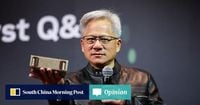The global race to dominate artificial intelligence (AI) has shifted into overdrive, with trillion-dollar bets being placed from Silicon Valley to the Middle East, and from European capitals to the laboratories of Asia. In the first week of October 2025, the world witnessed a flurry of announcements and bold predictions that underscored just how high the stakes have become—and how quickly the landscape is changing.
At the heart of this transformation stands OpenAI, the company now valued at a staggering $500 billion and recognized as the most valuable in the world, even outpacing Elon Musk's SpaceX. Its CEO, Sam Altman, has embarked on a whirlwind international campaign to secure the chips, manufacturing muscle, and financing needed to fuel OpenAI’s ambitions. According to The Wall Street Journal, Altman has spent recent weeks crisscrossing Asia, meeting with leaders at Taiwan Semiconductor Manufacturing Co., Foxconn, Samsung Electronics, SK Hynix, and Hitachi. The goal? To persuade these giants to ramp up production and prioritize OpenAI’s orders in an increasingly tight global chip market.
"Our vision is simple: we want to create a factory that can produce a gigawatt of new AI infrastructure every week," Altman wrote in a recent blog post. It’s not just talk—the numbers are eye-watering. OpenAI may spend $16 billion on server rentals this year alone, with projections leaping to $400 billion by 2029. The company’s memory-chip needs could soon outstrip the world’s entire high-bandwidth memory capacity, highlighting the scale—and urgency—of the endeavor.
But Altman’s quest doesn’t end in Asia. He is also set to visit the United Arab Emirates, seeking investments from Abu Dhabi’s Mubadala and MGX funds to bankroll OpenAI’s next generation of data centers, including the ambitious Stargate facility. Partnerships with Oracle, Nvidia, and SoftBank are already in place, with plans to deploy at least 10 gigawatts of Nvidia computing systems and open five new U.S. data centers. Each center carries a price tag of $50 billion, and the overall expansion could reach $850 billion, consuming as much energy as 17 nuclear power plants and potentially powering over 13 million American homes.
Altman is candid about the scale and risk of these investments. In August, he likened today’s AI spending spree to the dot-com bubble of the late 1990s. “People should expect OpenAI to spend trillions of dollars on AI infrastructure,” he said, acknowledging that economists might balk at the sums involved. Nevertheless, OpenAI is forging ahead, even exploring novel financial instruments to keep the money flowing.
Meanwhile, back on Earth—and perhaps soon, above it—Amazon founder Jeff Bezos is thinking even bigger. Speaking at Italian Tech Week in Turin on October 5, Bezos painted a vision that sounds like science fiction: within two decades, he said, gigawatt-scale data centers will orbit the planet, powered by endless solar energy, free from the clouds and weather that limit terrestrial sites. “These giant training clusters will be better built in space,” Bezos insisted, arguing that the economics would eventually favor orbital infrastructure over ground-based alternatives. Yet he also cautioned that space data centers carry serious risks, from rocket failures to astronomical costs and daunting maintenance challenges.
Bezos’ optimism about AI is undimmed. He compared the current fervor to the early days of the internet, warning of inevitable “bubble” phases but predicting that the impact of AI would be “deep, lasting and everywhere.” Already, the flow of capital is staggering. Gartner reports that AI-related spending will top $1.5 trillion in 2025 and surpass $2 trillion in 2026—nearly 2% of global GDP. Nvidia, the chipmaker at the center of the AI hardware race, has pledged $100 billion to support OpenAI’s expansion. The Stargate project alone aims to raise $500 billion by 2029 to build Texas data centers the size of Manhattan.
Yet all this ambition has sparked concern among analysts. Some warn of “circular funding” practices, where companies like Nvidia invest in startups that, in turn, spend their funding on Nvidia’s chips—potentially inflating the market in ways reminiscent of past speculative bubbles. Bain & Company estimates that AI’s insatiable computing appetite could demand $500 billion in annual data center investment through 2030, requiring $2 trillion in yearly revenue just to break even. Even the most optimistic projections leave an $800 billion funding gap.
Still, believers remain undeterred. “We are in 1996, not 1999,” said Dan Ives of Wedbush Securities, referencing the early days of the internet boom. “Many investments will go up in smoke,” he conceded, “but the technology—like the web before it—will endure.”
Across the Atlantic, Europe is scrambling to keep pace. At the same event in Turin, European Commission President Ursula von der Leyen called for an “AI first” strategy to jumpstart the continent’s lagging tech sector. “Self-driving cars are already a reality in the United States and China. The same should be true here in Europe,” she declared. Von der Leyen’s plan includes launching pilot networks for autonomous vehicles across European cities, with 60 Italian mayors already on board. “The future of cars—and the cars of the future—must be made in Europe,” she asserted, underscoring the urgency of reclaiming industrial leadership.
But the Achilles’ heel of the AI revolution is power. By 2030, experts predict that the sector’s computing footprint could reach 200 gigawatts—roughly the annual electricity consumption of Brazil. Half of that demand is expected to come from the United States. Tech giants are investing billions in renewable energy, and Bezos’ vision of orbital data centers is partly driven by AI’s voracious appetite for power. Environmentalists, however, warn that the industry risks trading digital progress for ecological peril.
Amid all the hype and hand-wringing, one fact stands out: as of October 2025, AI is no longer a distant possibility. It is, as The Express Tribune put it, the “defining reality of the 21st century.” OpenAI now serves 700 million users—nearly 9% of humanity. Altman predicts that, by 2030, AI could surpass human intelligence in key domains, tackling scientific discoveries and tasks beyond human reach. Addressing fears of AI turning hostile, Altman has repeatedly stressed the importance of aligning AI with human values, insisting that it will remain a powerful tool rather than a threat.
The story of AI in 2025 is one of breathtaking ambition, sky-high risk, and a relentless drive to shape the future. Whether the next leap comes from a Texan data farm, a European smart car, or a solar-powered server whirring above the clouds, one thing is certain: the world’s biggest gamble is already underway, and there’s no turning back.

